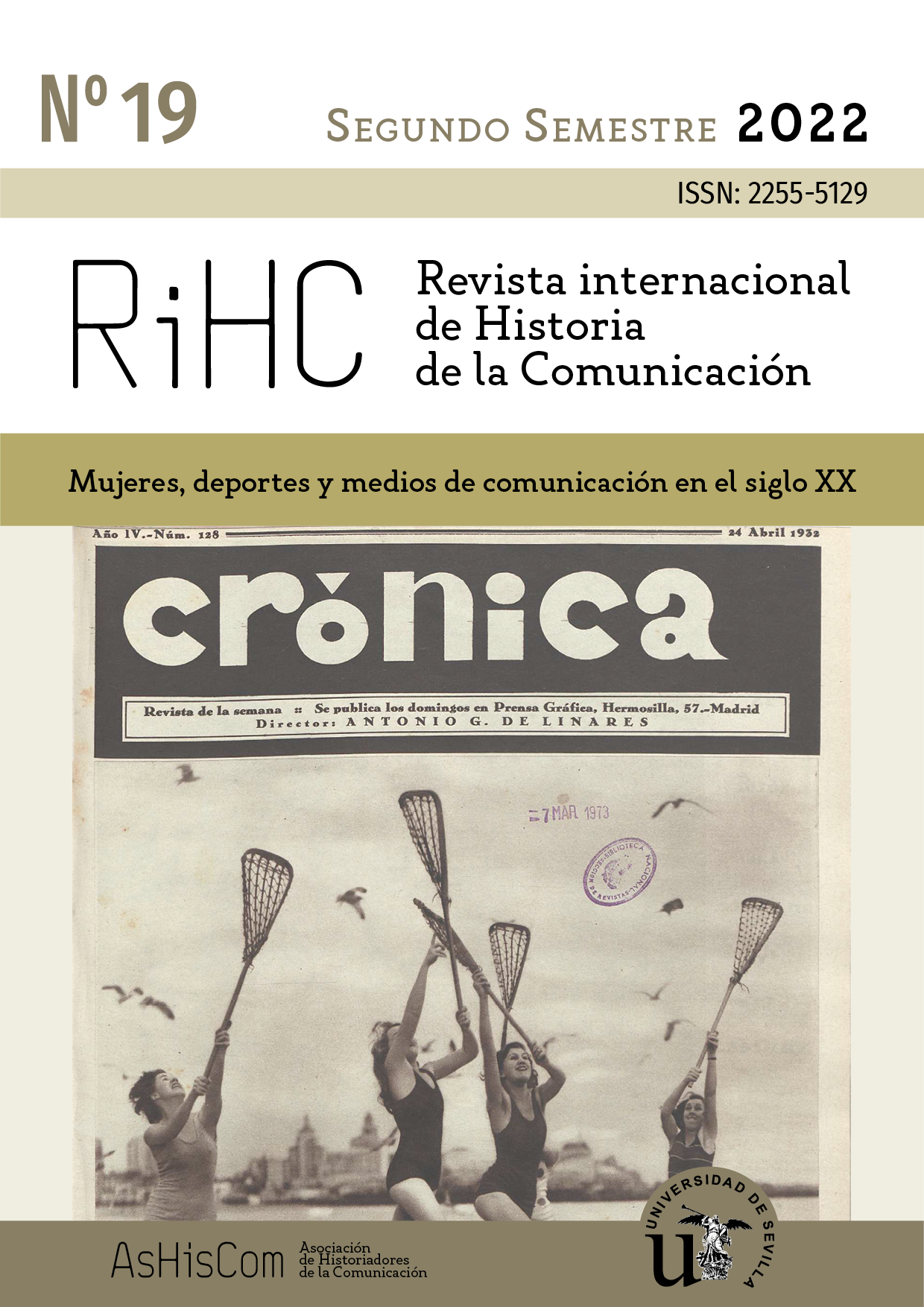The senses and meanings of female fans in soccer events in Belo Horizonte-Brazil (1913-1927)
DOI:
https://doi.org/10.12795/RiHC.2022.i19.02Keywords:
Soccer, Female attendance, Habitus, Belo HorizonteAbstract
The article analyses the attendance of women in soccer events in Belo Horizonte from 1913 to 1927. During this period, especially in the capital of the state of Minas Gerais, the press highlighted the participation of elite women in sports events. Furthermore, the analysis holds the hypothesis that women attendance in events related to soccer enabled the development of a new female habitus resulting from symbolic exchanges fostered by interactions in public.
Downloads
References
BONFIM, A. (2019). Football Feminino entre festas esportivas, circos e campos suburbanos: uma história social do futebol praticado por mulheres da introdução à proibição. Trabalho final de mestrado: Escola de Ciências Sociais, Fundação Getulio Vargas.
BOTELHO, L. (2022). Elas e o Clube Atlético Mineiro. En DUCCA, C. et al. (coords.). Nós Somos do Clube Atlético Mineiro: a história do Galo. Belo Horizonte: Onze Cultural.
BOURDIEU, P. (1971). Le marché dês biens symboliques. L'Année sociológica. Paris: PUF.
BOURDIEU, P. (1979). La distinction. Paris: Minuit.
COLLINS, P.; BILGE, S. (2021). Interseccionalidade. São Paulo: Boitempo.
D’INCAO, M. (2002). Mulher e família burguesa. En DEL PRIORE, M. (coord.). História das mulheres no Brasil. São Paulo: Contexto, pp. 223-240.
COUTO, E. (2003). Belo Horizonte e o futebol: integração social e identidades coletivas (1897-1927). Trabalho final de mestrado: Pontificia Universidade Católica de Minas Gerais.
ELIAS, N.; DUNNING, E. (1996). Deporte y ócio em el proceso de la civilización. México: Fondo de Cultura Económica.
FRACCARO, G. (2017). Mulheres, sindicato e organização política nas greves de 1917. Revista Brasileira de História, v. 37, pp. 73-90.
HOBSBAWM, E. J. (1979). A era do capital: 1848-1875. Rio de Janeiro: Paz e Terra.
JULIÃO, L. (1996). Itinerários da cidade moderna (1891-1920). En DUTRA, E. (coord). BH: horizontes históricos. Belo Horizonte: C/Arte, pp. 60-117.
MELO, V. (2010). Esporte, cidade e modernidade: Rio de Janeiro. En MELO, V. (coord.) Os sports e as cidades brasileiras: transição dos séculos XIX e XX. Rio de Janeiro: Apicuri, pp. 19-48.
NEVES, L. A. (2000). Memória, História e sujeito: substratos da identidade. História Oral: Revista da Associação Brasileira de História Oral, n.3, pp. 109-116.
PEREIRA, L. (2000). Footballmania: uma história social do futebol no Rio de Janeiro (1902-1938). Rio de Janeiro: Nova Fronteira.
QUINTANEIRO, T. (1995). Retratos de mulher: o cotidiano feminino no Brasil sob o olhar dos viageiros do século XIX. Petrópolis: Vozes.
RIBEIRO, R. (2007). A bola em meio a ruas alinhadas e a uma poeira infernal: Os primeiros anos do futebol em Belo Horizonte (1904-1921). Trabalho final de mestrado: Universidade Federal de Minas Gerais.
RODRIGUES, M. (2006). Constituição e enraizamento do esporte na cidade: uma prática moderna de lazer na cultura urbana de Belo Horizonte (1894-1920). Trabalho final de doutorado: Universidade Federal de Minas Gerais.
SALGUEIRO, H. (1997). Engenheiro Aarão Reis: o progresso como missão. Belo Horizonte: Fundação João Pinheiro.
SCOTT, J. (1995). Gênero: uma categoria útil de análise histórica. Revista Educação & Realidade, v.20, nº 2, pp. 71-99.
SOUZA NETO, G. ; CAMPOS, P. ; SILVA, S. (2013). Das Senhoras e Senhorinhas nos ‘Grounds’ do Sport Bretão: a história da mulher nos campos de futebol em Belo Horizonte/MG (1904-1920). Licere (Centro de Estudos de Lazer e Recreação. Online), v. 16, pp. 1-13.
ZILLER, A.(1974). Enciclopédia do Atlético. Belo Horizonte: Leme.
Downloads
Published
How to Cite
Issue
Section
License
Copyright (c) 2022 RIHC. Revista Internacional de Historia de la Comunicación

This work is licensed under a Creative Commons Attribution-NonCommercial-ShareAlike 4.0 International License.
RiHC. Revista internacional de Historia de la Comunicación is an open access publication, offering its content under the principle that making research available to the public free of charge contributes to the greater exchange of global knowledge.
RiHC. Revista internacional de Historia de la Comunicación adheres to the various initiatives that promote access to knowledge. All content is therefore free of charge and is published under the Creative Commons Attribution-NonCommercial-ShareAlike 4.0 International license.
By virtue of this, the authors who publish in this journal accept the following conditions:
- Open access content may be freely shared (that is, copied and redistributed in any medium or format) and adapted (remixed, transformed and built upon).
- Attribution: The user of the content must give appropriate credit, provide a link to the license, and indicate if changes were made. This may be done in any reasonable manner, but not in any way that suggests the licensor endorses the user or their use.
- Non Commercial: The content may not be used for any commercial purpose.
- Share Alike: If the content is remixed, transformed or built upon, it must be distributed under the same licence as the original.
- No additional restrictions: No legal terms or technological measures may be applied that legally restrict others from doing anything the licence permits.



